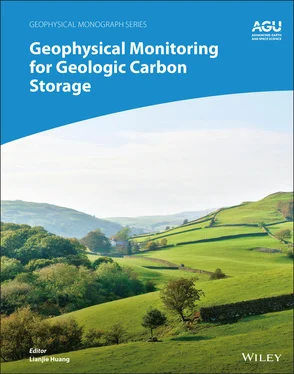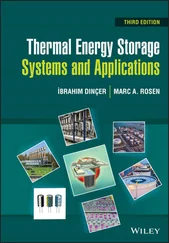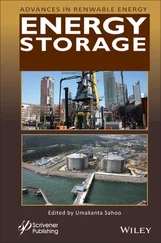Geophysical Monitoring for Geologic Carbon Storage
Здесь есть возможность читать онлайн «Geophysical Monitoring for Geologic Carbon Storage» — ознакомительный отрывок электронной книги совершенно бесплатно, а после прочтения отрывка купить полную версию. В некоторых случаях можно слушать аудио, скачать через торрент в формате fb2 и присутствует краткое содержание. Жанр: unrecognised, на английском языке. Описание произведения, (предисловие) а так же отзывы посетителей доступны на портале библиотеки ЛибКат.
- Название:Geophysical Monitoring for Geologic Carbon Storage
- Автор:
- Жанр:
- Год:неизвестен
- ISBN:нет данных
- Рейтинг книги:4 / 5. Голосов: 1
-
Избранное:Добавить в избранное
- Отзывы:
-
Ваша оценка:
- 80
- 1
- 2
- 3
- 4
- 5
Geophysical Monitoring for Geologic Carbon Storage: краткое содержание, описание и аннотация
Предлагаем к чтению аннотацию, описание, краткое содержание или предисловие (зависит от того, что написал сам автор книги «Geophysical Monitoring for Geologic Carbon Storage»). Если вы не нашли необходимую информацию о книге — напишите в комментариях, мы постараемся отыскать её.
Geophysical Monitoring for Geologic Carbon Storage
Volume highlights include: Geophysical Monitoring for Geologic Carbon Storage
The American Geophysical Union promotes discovery in Earth and space science for the benefit of humanity. Its publications disseminate scientific knowledge and provide resources for researchers, students, and professionals.
Geophysical Monitoring for Geologic Carbon Storage — читать онлайн ознакомительный отрывок
Ниже представлен текст книги, разбитый по страницам. Система сохранения места последней прочитанной страницы, позволяет с удобством читать онлайн бесплатно книгу «Geophysical Monitoring for Geologic Carbon Storage», без необходимости каждый раз заново искать на чём Вы остановились. Поставьте закладку, и сможете в любой момент перейти на страницу, на которой закончили чтение.
Интервал:
Закладка:
The injection of carbon dioxide results in increased resistivity, which may be detected by electrical and EM imaging techniques, such as electrical resistivity tomography, complex resistivity method, magnetotelluric method, controlled source EM, and other EM methods. In Chapter 15, Gasperikova and Morrison present the electrical and electromagnetic (EM) techniques to map the electrical resistivity of the subsurface for monitoring CO 2injection and migration. Both surface and borehole resistivity methods are relatively insensitive to horizontal resistive layers of CO 2plumes. Monitoring with electromagnetic sources at depth shows great promise for detecting and monitoring the emplacement of tabular zones or bodies of resistive CO 2. Surface‐based EM techniques with an induction coil source are not suitable for detection of CO 2plumes deeper than 1,000 m.
Electrical and EM methods can be used to monitor CO 2leakage into the shallow geologic formations. Gas‐phase CO 2increases the bulk electrical resistivity. On the other hand, brine leakage and dissolved CO 2in groundwater decrease the electrical resistivity. Electrical and EM monitoring should account for both effects of fluid salinity and CO 2saturation.
Electrical resistivity tomography (ERT) is an alternative high‐resolution technique for the shallow aquifer and deep reservoir monitoring. In Chapter 16, Yang and Carrigan describe the ERT method for tracking migration of a supercritical CO 2plume in a deep storage reservoir and for detecting CO 2leakage in a shallow aquifer. With downhole electrodes close to the target of interest, ERT can characterize the temporal and spatial resistivity changes effectively. A resistive supercritical CO 2plume displaces conductive brine and increases the bulk resistivity of storage formation. However, brine leakage and CO 2dissolution in a shallow aquifer lower the bulk resistivity of the formation. They present two case histories to demonstrate the capability of ERT that provides daily tomographic images of CO 2distribution, which complements temporally sparse wireline logs and cross‐well seismic data. The surface ERT method is effective for monitoring shallower than 100 m in depth. The primary challenge of cross‐well ERT is the high cost of using two or more closely spaced monitoring wells to deploy vertical electrode arrays. Single‐well ERT may be used when closely spaced monitoring wells are not available.
The controlled source electromagnetic (CSEM) method is mostly an offshore monitoring technique using electromagnetic remote‐sensing technology to map the electric resistivity distribution of the subsurface. In Chapter 17, Tveit and Mannseth introduce a Bayesian sequential inversion methodology for combining geophysical data types of different resolutions. They first use CSEM or gravimetric data to invert for a low‐resolution result, which is used as prior information for inversion of seismic amplitude‐versus‐offset (AVO) data to improve resolution. The unknown geophysical parameters, for example, electric conductivity, density, and seismic velocity, are represented using a carefully designed parameterization based on the level‐set framework, which allows for representation of region boundaries defined by the large‐scale CO 2plume and slowly varying geophysical properties inside and outside the CO2 plume. They show that seismic AVO inversion results are improved with the sequential inversion methodology using prior information from either CSEM or gravimetric inversion.
Fluid flow through a porous media can generate electrical potential gradient or streaming potential along the flow path. The self‐potential (SP) technique is a passive electrical monitoring method that measures spontaneous or natural electrical potential from the subsurface. In Chapter 18, Nishi and Ishido introduce the SP monitoring technique. Two SP mechanisms are studied with numerical simulations. The electrokinetic coupling mechanism produces SP caused by changing reservoir conditions such as pressure disturbance from results of reservoir simulation. The geobattery mechanism creates a galvanic cell caused by subsurface electrochemical conditions near a metallic well casing. CO 2injection alters deeper reducing environment and redox potential, which results in an SP anomaly. If a substantial amount of CO 2migrates upward into a shallow fresh water aquifer through a vertical fault and creates substantial pressure disturbances, observable self‐potential measurements caused by electrokinetic coupling would provide a cost‐effective monitoring method for CO2 leakage detection. They observed a local self‐potential increase near the wellhead of an injection well associated with CO 2injection at the Aneth oil field in southeastern Utah, USA.
1.5. CASE STUDIES OF GEOPHYSICAL MONITORING
In Chapter 19, Bauer et al. present a case study of microseismic monitoring at the Illinois Basin Decatur Project of the Midwest Geological Sequestration Consortium. The project site is located in east‐central Illinois in the north‐central area of the Illinois Basin in the midcontinent region of the United States. For over three years, the project safely injected nearly 1.1 million tons of supercritical carbon dioxide into the base of a 500‐m thick saline sandstone reservoir at a depth of 2.14 km. They collected a unique data set encompassing an extensive quantity of microseismic and concurrent operational monitoring data before, during, and after injection operations, and presented results of microseismic event location and focal mechanisms. They demonstrate the compatibility of technical and operational activities under evolving and challenging conditions.
In Chapter 20, Balch and McPherson present an overview of the Phase III of the Southwest Partnership on Carbon Sequestration (SWP) in Farnsworth, Texas, USA. The project has completed its injection period with the storage of over 700,000 tonnes of CO 2at an active commercial‐scale CO 2‐EOR field. They summarize the interrelationship of monitoring activities, the status of postinjection monitoring, and the optimization required to maximize storage while providing the greatest oil production incentive to the field operator, among others.
In Chapter 21, Hovorka gives an experimental study of testing and assessing geophysical monitoring methods for tracking CO 2migration during large volume injection at the Southeast Regional Sequestration Partnership project in Cranfield, Mississippi, USA. The project uses several geophysical tools to detect CO 2in the injection zone, including time‐lapse 3D seismic, 3D VSP, time‐lapse cross‐well seismic, electrical resistance tomography, borehole gravity, time‐lapse wireline sonic, pulsed neutron logging, and fluid density logging. The experiment reveals the strengths and weaknesses of different monitoring methods. Interference among different monitoring tools is significant. The site operator should avoid deploying as many tools as possible, but rather select best tools for the job and deployment condition. Monitoring data play an important role in calibrating the reservoir model.
In Chapter 22, Romdhane et al. describe a case study on quantitative monitoring at Sleipner in Norway. They evaluate a methodology combining high‐resolution seismic‐waveform tomography and rock physics inversion for monitoring the CO 2plume at Sleipner. They show that using multiparameter seismic inversion or multiphysics integration of data can lead to a better discrimination between the different effects of CO 2injection/migration on rock physics properties and reduce inversion uncertainties.
Finally, in Chapter 23, Bergmann et al. present an overview of geophysical monitoring of CO 2injection at Ketzin in Germany. They describe seismic measurements and electrical resistivity tomography performed during the period of site development and CO 2injection. They find that a combination of several geophysical methods is preferred.
Читать дальшеИнтервал:
Закладка:
Похожие книги на «Geophysical Monitoring for Geologic Carbon Storage»
Представляем Вашему вниманию похожие книги на «Geophysical Monitoring for Geologic Carbon Storage» списком для выбора. Мы отобрали схожую по названию и смыслу литературу в надежде предоставить читателям больше вариантов отыскать новые, интересные, ещё непрочитанные произведения.
Обсуждение, отзывы о книге «Geophysical Monitoring for Geologic Carbon Storage» и просто собственные мнения читателей. Оставьте ваши комментарии, напишите, что Вы думаете о произведении, его смысле или главных героях. Укажите что конкретно понравилось, а что нет, и почему Вы так считаете.












